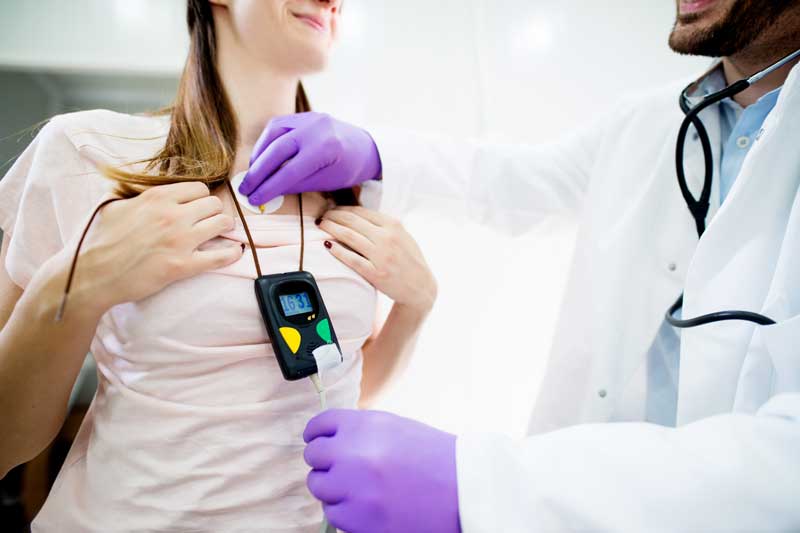Common Tests for Arrhythmia
Several tests can help your health care professional diagnose an arrhythmia and monitor the effectiveness of your treatment.
Holter monitor

You can think of a Holter monitor (or continuous ambulatory electrocardiographic monitor) as a small, portable electrocardiogram (EKG or ECG) recorder.
Holter monitors can record 24 hours or more of continuous electrocardiographic signals. This gives health care professionals a “movie” of the heart’s electrical activity, as opposed to the much shorter glimpse provided by an EKG.
Your health care professional may ask you to keep a diary of your activities and symptoms. Later, the Holter monitor results can be compared to your daily log to see how your activities or symptoms correspond to your measured heart rhythm.
Learn more about Holter monitors.
View a printable Holter monitor diary (PDF).
Cardiac event recorder
For suspected arrhythmias that occur infrequently or pass quickly, your health care professional might suggest that you wear a cardiac event recorder.
Various kinds of event monitors attach with bracelets, finger clips or patches worn under the arms for a month or two. The data about your heart’s electrical system is recorded and stored. You can then transmit the results to your health care professional to be analyzed.
Learn more about cardiac event recorders.
Stress test or exercise stress test
A stress test or an exercise stress test can help diagnose people whose suspected arrhythmias are caused by exercise.
In an exercise stress test, you walk or run on a treadmill or ride a stationary bicycle while your heart rate and rhythm are monitored. This can cause an arrhythmia, allowing your health care professional to study the abnormal heartbeat.
Learn more about a stress test.
Tilt-table test
A tilt-table test may be suggested if you’ve suffered fainting spells. It reveals how your heart rate and blood pressure respond when changing positions from lying down to standing up.
In this test, a catheter may be placed in an artery to monitor blood pressure from within the blood vessel. An IV line (a small plastic tube in a vein) may also be started before the test.
If the cause of the fainting spells is not initially discovered, medications can be supplied through the IV line or by mouth to help produce the episodes.
Learn more about tilt-table tests.
Electrophysiologic testing
Electrophysiologic testing, also called an EP study, can reveal suspected arrhythmias.
In this procedure, performed under local anesthesia, temporary electrode catheters are threaded through peripheral veins (or arteries) into the heart. These catheters are positioned in the atria, ventricles or both. They record the heart’s electrical signals and “map” the path of electrical impulses during each heartbeat.
This test can cause known but infrequent arrhythmias, allowing them to be diagnosed. It can help trigger hidden tachycardia (fast heart rate) or bradycardia (slow heart rate).
Transesophageal electrophysiologic procedure
In this procedure, a thin, flexible catheter is inserted into your nostril and positioned in the esophagus (the tube that connects the mouth and stomach). The catheter’s lead performs an electrocardiogram (EKG). The catheter’s proximity to the heart allows for more accurate results than a normal EKG.
This procedure can cause unpredictable arrhythmias for diagnosis. Medications can be administered as part of the test to determine the most effective approach.
Echocardiogram
An echocardiogram is a painless procedure that uses ultrasound waves to reveal your heart’s size, structure and motion. This type of echocardiography uses sound waves in much the same way that an ultrasound test uses sound waves to monitor a baby’s growth in the womb.
An echocardiogram often provides valuable information about a heart with an arrhythmia. The most common type of echocardiogram is transthoracic echocardiography (TTE).
Learn more about echocardiography.





